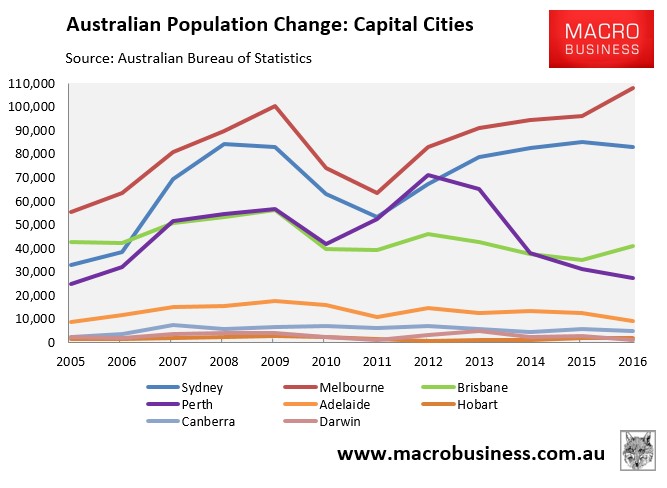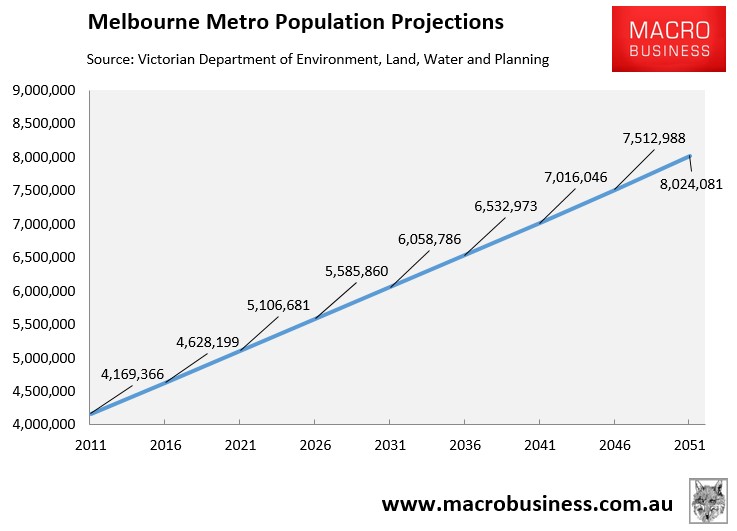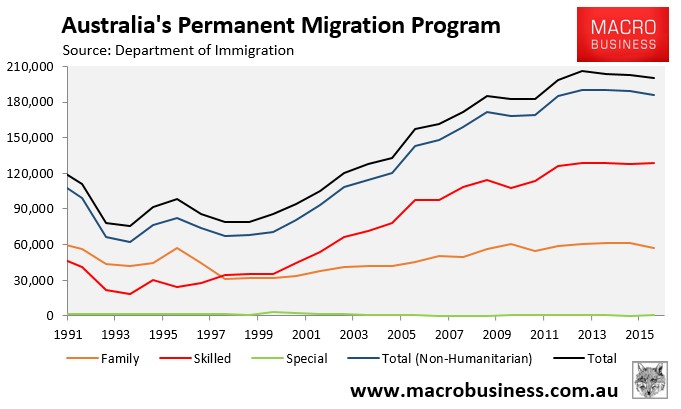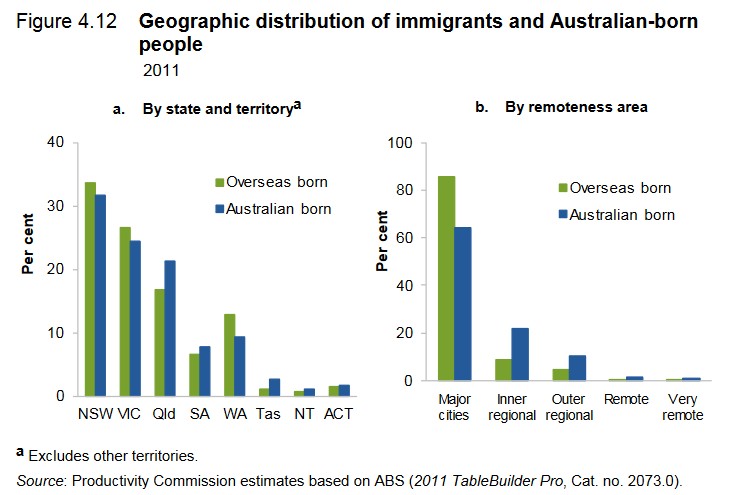In late 2015, in a great twist of irony, one of the people responsible for the proliferation of high rise dog boxes across Melbourne – former planning Minister (now Opposition Leader) Matthew Guy – had a Damascus moment and questioned the merits of high immigration into Melbourne:
“I think there has got to be a genuine community, business and governance discussion about how we really focus on building the population of our regions, because I am very, very sure that the four-and-a-half million people of Melbourne think … our city is bursting,” Mr Guy said. “Can you imagine it with another million people on top of this, as it will be within 15 years time?”
Then in May 2016, Guy went even further claiming that “managing population growth is Victoria’s biggest challenge”:
Every year Victoria’s population grows by the size of a packed MCG… and 92 per cent of them are headed towards Melbourne.
So it is no wonder that strained and congested infrastructure is something Victorians experience every day…
Our roads are clogged, our trains are full and we can’t get inside trams let alone find a seat on one.
Managing the growth of our population is the biggest challenge Victoria faces today…
Then in November 2016, Guy returned claiming that almost doubling Melbourne’s population to 8 million is unsustainable and calling for population growth to be shifted to the regions:
All of Melbourne’s problems are intrinsically linked to this [population] growth, and it requires a government of vision and purpose to adequately respond to these challenges for the sake of us all… Our vision for Victoria is a state of cities, not a city state…
For too long, governments have ignored decentralisation… An effective decentralisation agenda is crucial to underpinning our desire to improve Melbourne’s liveability and economic growth of the regions…
Then in February, Victoria’s Shadow Parliamentary Secretary to the Leader (Population Policy and Housing Affordability), Tim Smith, again warned that Melbourne’s population growth is unsustainable and called for growth to be diverted to the regions:
The vastness of Melbourne is something to behold and the centralising of Victoria’s population continues as 92 per cent of new arrivals to Victoria stay in the capital.
Victoria is growing by one person every five minutes, more than 100,000 a year… We have seldom seen population growth like it… Victoria’s present growth dwarfs the population booms of the 1850s and 1960s, and is contributing towards an infrastructure crisis characterised by severe road congestion, overcrowded public transport, schools bursting at the seams and a scarcity in the residential house market that is taking home ownership out of reach of many young Melburnians…
Melbourne is nowhere near as liveable as it was… Opposition Leader Matthew Guy’s vision is to decentralise Victoria and develop its regional cities, to take the pressure off Melbourne and grow country Victoria… The state desperately needs a government that is committed to decreasing the percentage of newcomers who make their home in Melbourne… We want to see more people commuting to Melbourne from regional Victoria — we can’t have a Melbourne that expands forever… An effective decentralisation agenda is key to improving capital city liveability and the economic wellbeing of the regions.
This month, the Liberal candidate for Brighton, James Newbury, penned an article in The Age warning that the Labor Government’s planning reforms will wreck the suburbs and reiterated the call for Victoria’s population growth to be shifted to the regions:
Your home, as they say, is your castle. That’s why for most of us, our suburb is a bit like our local village… Our villages are getting more cramped, they are getting taller, and finding parking has become a daily chore…
In recent weeks – with little fanfare – the Andrews government slipped through a so-called “refresh” of planning laws, which encourages increased densification. Under the changes there will be less new housing built in Melbourne’s outer growth areas, and more built within 20 minutes of the city.
The densification strategy is Andrews’ solution to Victoria’s population doubling over the next 30 years. To cope with the strain of that intense population growth, the government intends to allow more development on each piece of land, by scrapping the two residences on a neighbourhood block rule…
The only way to keep the character of our suburbs, preserve our neighbourhoods, and cater for intense population growth, is to expand Melbourne, develop satellite hubs, and attract people towards regional centres.
As a lifelong Melbournian, I too have watched in disbelief as Melbourne’s population has expanded at a frantic rate, growing by a whopping one million people (27%) in the 12 years to June 2016:

Anyone that has lived in Greater Melbourne over this period will agree that living standards are being eroded. Roads and public transport have been crush-loaded and housing has become hideously expensive.
The situation is set to deteriorate further if Melbourne’s population grows as projected by the State Government. According to these projections, Melbourne will add on average 97,000 people per year (1,870 people per week) for the next 35 years – adding the equivalent of around 9 Canberras or 2.5 Adelaides to the city’s population:

While the State Liberal Party’s concerns are justified, how realistic is their solution to decentralise? The key driver of Melbourne’s projected population growth is the federal government’s mass immigration program:

And to date, migrants have always chosen to settle in the big cities of Melbourne and Sydney, rather than the regions:

Decentralisation has been on Australia’s political agenda for around 100 years without success (other than the creation of Canberra). So what makes the Victorian Liberals believe they can magically turn the situation around?
Short of locating government departments to the regions, what can the State Government realistically do?
And what good is decentralisation if all it means is that ‘urban sprawl’ is replaced by ‘regional sprawl’ as the regions simply become commuter towns for Melbourne? Or, to put it another way, regional dormitory suburbs are created instead of fringe suburbs?
Rather than accepting mass immigration as a fait accompli, the State Liberal Party should instead lobby their federal counterparts to establish a national population policy that reduces immigration and does away with a ‘Big Australia’ on the grounds that is is placing undue strain on infrastructure and housing, and is reducing living standards of incumbent residents.
Victoria’s politicians should also lobby for a greater share of tax revenues on the grounds that they are incurring the lion’s share of the costs from immigration, in the form of providing expensive infrastructure and social services.
To the Liberal Party’s credit, they have at least recognised that Melbourne’s population growth is both unsustainable and unwanted. But they need to look at the root cause – excessive levels of immigration – and seek to bring it back down to sensible and sustainable levels.
For its part, the Labor Government needs to open its eyes. Few Melbournians want a city of 8 million people. The one we have already is barely functioning properly at 4.6 million.

